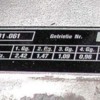Hi, I got a very nice built #1493; it is '72 in the papers but seems to be a '71; it has /1 rear mount ZF.
I am going to ship it to Europe so it will be longer distance, high speed driven.
When I bought the car I got 2 boxes full of documentation, receipts, etc....From all the documentation and also talking to cars second owner who built the engine in 90's I figured up it is following spec:
4V 351C block, stock crankshaft, stock connecting rods and pistons with bushings installed for oiling modification
Australian 3V aluminum head with SS valves, aluminum Hi-rise intake (this ware added later, there is '06 receipt from PI)
780 CFM Holley carburetor
ISKY Solid Roller Camshaft, roller rockers (the problem here is that there is no way to find spec on this Camshafts as receipt only says "custom grind"; they ware installed same time as the aluminum heads)
10 Quart oil pan
Mallory Unilite Distributor, coil and wires
Even that second owner (who was a mechanic himself) told me he build the engine for longevity I was also told that there could be some issues using solid roller camshafts on longer distances. I am not sure, but I guess my distributor gear should be brass, so prone to wear.
Also, if I am correct , my /1 ZF would have .846 fifth gear (got this from Detomaso book, might be misprint?), so, if my calculation is correct, to get to 130mph I would be over 6000 RPM; really worried how long would my motor last this way....
I would really appreciate to get some advice on what modifications would be good to do in order to not have to worry when taking longer trips. Should I consider changing to hydraulic lifters, but then high RPM becomes even more of the issue? Or will it be OK to leave the engine as it is and just watch for distributor gear wear and replace it as necessary?
Original Post


